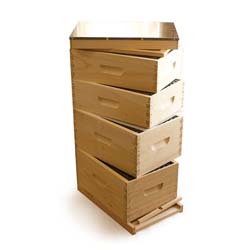Honey bees collect nectar to turn it into honey. Nectar in its true form has a high moisture content (generally 70-80%). That moisture level is too high to be stored as is, resulting in fermentation instead of honey. Instead, honey bees will fan their wings over the uncapped nectar stores, working to get the moisture content to an acceptable level. Once the cell is full enough and the moisture content is perfect (somewhere between 16-18.5%), the bees will cover the cell in wax capping, protecting it from water, the elements, or potential invaders. Those capped honey cells are what beekeepers harvest honey from.
When harvesting and bottling honey, the moisture content is very important. For harvesting purposes, you want to aim for a moisture content of 18.5% or lower. You can use a refractometer to get an exact reading of the moisture content of your honey. When harvesting, search for frames that are at least 75% capped honey. This will give you a better moisture content level. The more capped, the better for extracting!
If you have frames that aren’t quite there or your moisture content is too high, you can either: leave the frames in a room with fan(s) blowing to draw out some of the water or leave the filtered honey in its bucket and placing a fan over it, allowing the water to be drawn out.
